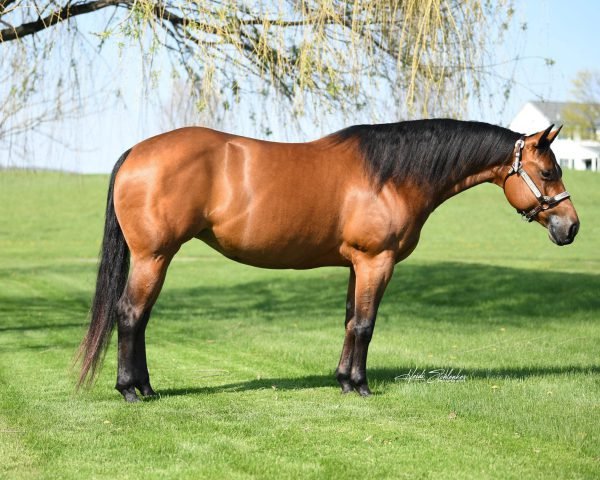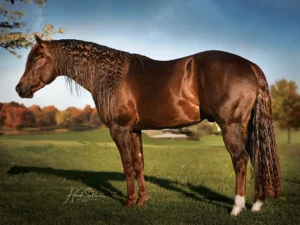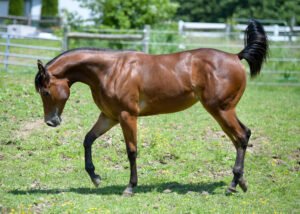The Power of a Refined Horse Head: Why It Matters More Than You Think
Focus Keyword: Refined Horse Head
We’ve all heard it: “You don’t ride the head.”
Except… yeah. You actually do. In fact, some riders are practically riding the entire face, neck, and half the horse’s shoulder with their whole upper body. 😂
I’m not saying looks are everything, but when I’m evaluating a horse—whether for breeding or training—I absolutely study the head. Not just because I want a pretty one at the end of my lead rope (though, let’s be honest, I do). The structure of the head directly affects responsiveness, trainability, and how much effort you’ll need to put in.
Let’s break this down with two of my own horses so I don’t ruffle any feathers on the internet. 👇
📸 The Liver Chestnut Stallion: A Case Study in Refined Horse Head

This is my stallion. Take a look:
- Refined muzzle
- Thin lips and chin
- Wide forehead
- Big jowls (because stallion)
- Soft, expressive eye
- Small fox-like ears
- Clean throatlatch
He’s got the full package—not just in the “pretty-boy” sense, but in the “dang, he’s easy to ride” sense. He’s light, soft, and responsive. Vertical flexion? Automatic. Frame? Natural. Collection? Maintained with minimal input.
This refined horse head reads the reins like they’re Braille. That’s how I like them.
📸 The Bay Mare: Beauty with Coarser Features

Here’s my mare. She’s gorgeous. She’s intelligent. She produces stunning babies. But we need to be honest—
- Her muzzle is coarse
- Thick lips
- Meatier chin
- More “Captain Caveman” than “delicate dancer”
- Her bottom lip hangs loose when relaxed, sometimes with drool
She’s highly trainable, but in terms of softness in the bridle? Compared to my stallion, she needs more pressure. Her reaction time is slower. Think of the difference between texting with a touchscreen vs. using a rotary phone. You’ll get there… it just won’t be as smooth. 😂
Here’s the kicker: Even a horse with a coarse head can achieve remarkable softness in the bridle. It just takes longer and requires a bit more finesse from the rider.
🧠 The Science Behind the Refined Horse Head
The horse’s head and muzzle are packed with sensory nerves that detect pressure, movement, and contact from the reins:
Key Cranial Nerves:
- Trigeminal Nerve (Cranial Nerve V): Governs sensation in lips, muzzle, and jaw.
- Facial Nerve (Cranial Nerve VII): Controls lip and nostril movement.
This is why horses can feel a fly land on their lip—and why a slight rein cue should suffice with a refined horse head.
✅ Why a Refined Horse Head Equals Responsiveness
The refined features aren’t just aesthetic. Here’s what they offer:
- Tapered Muzzle: Less padding = sharper signal recognition.
- Thin Lips & Chin: Increased nerve access = quicker reaction time.
- Wide Forehead: Often correlated with broader brain capacity = better thinkers.
- Clean Throatlatch: Allows for freer flexion and smoother collection.
In short, the more refined the horse head, the more effortless and precise the communication between horse and rider. And that’s what every serious rider should strive for.
❌ What a Coarse Horse Head Can Mean for Training
There are trade-offs with coarser heads:
- Thick lips and jowls: Like texting while wearing oven mitts—delays and dulls signals.
- Blocky muzzle: Requires more hand; slower to respond.
- Chunky throatlatch: Restricts flexion; often results in bracing, head-tossing, or stiffness.
So when someone says, “You don’t ride the head,” they’re overlooking the fact that your hands communicate through it all day long.
Conclusion: You Do Ride the Head
And for me? I want that signal clean, clear, and quick.
Refined horse heads mean responsive rides. Coarse heads mean conversations that need subtitles and repeated cues. 😅
I’d love to hear your thoughts—do you consider head shape when selecting a horse for breeding or training? Or is it just about the “pretty” for you?
Explore more horse conformation insights here →
FAQs About Refined Horse Heads
1. What does a refined horse head indicate?
It typically suggests a horse with heightened sensitivity, better nerve access, and greater responsiveness to cues.
2. Can a horse with a coarse head still be responsive?
Yes! With proper training and consistent pressure cues, any horse can learn softness and subtlety in the bridle.
3. How can I evaluate a horse’s head for training suitability?
Look at the muzzle shape, lip thickness, jaw definition, and throatlatch. The more tapered and clean these areas are, the easier rein communication tends to be.
4. Does head shape influence bridle fit?
Absolutely. Refined heads often require smaller, more delicate tack to avoid overcorrection or discomfort.
5. Are refined horse heads more common in certain breeds?
Yes. Breeds like Arabians and certain Quarter Horse lines tend to show more refinement, especially in performance-bred individuals.




Leave a Reply